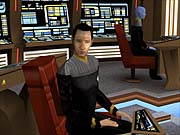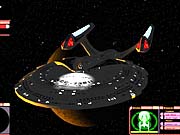Star Trek Bridge Commander Designer Diary #2
Totally Games' David Litwin recaps the steps that his team took to create and shape the story of Star Trek Bridge Commander.
Entry #2 - 02/05/02
By David Litwin
Director of Technology and Project Lead, Totally Games
The difficult part about talking about our story development is that at its heart the story of Bridge Commander is a mystery. This means to really describe the process I'd have to give away part of what makes it interesting. So I'll do what I can and just leave the rest for those who buy the game.

The creation of a story for a large and complex game at Totally Games is never a small effort. Our games have been known for their depth and detail, and what we were trying for in Bridge Commander would require no less. The game style of Bridge Commander was designed to have no discernable individual missions but instead a smooth flow from beginning to end. We were also creating a game where direct interaction with characters was a major interface. Our history, the game design, and the license of Star Trek make a large and detailed story a given.
For a number of weeks the team brainstormed and discussed myriad story ideas. We had to keep in mind the license (Star Trek: The Next Generation), the time period (just after the Dominion war), and the characters from the license we intended to use. We narrowed it down fairly quickly to Picard and Data, and possibly Worf. Sure, it would have been nice to use the entire cast, but when designing a game where you assume the role of captain, it's hard to closely integrate all the cast of the Enterprise without you being on that ship. And having you take over the Enterprise just wasn't realistic. Our decisions on characters were also driven by character popularity and how we might be able to work them into the story ideas we had.
After reducing our long list of ideas to a small few, we began to merge the remaining contenders and flesh them out. At this stage we began moving past simple opinion and to many issues that involved all disciplines of development for their expertise. It was crucial to have the artists involved to make sure the opening, ending, and other cutscene moments of the story could be properly and dramatically told. Story on paper may not work well visually. The designers need to consider scenarios and how they fit into the arc of the story. The programmers need to make sure that everything in the story can be technically realized.
The end result of this process was a great story that was grounded in a cataclysmic event, the search and gradual discovery of the cause, coalition building (diplomacy), and a strong finale, all sprinkled with lots of stuff blowing up along the way. Kind of what we have in the story now, but with some fundamental differences--our original plot (and this gives nothing away, as we changed it) involved the Borg and Romulans as major forces in the story.
To digress for a bit, I've never found Superman to be an interesting superhero (I was always a big Iron Man collector). The problem I had with Superman was that his powers were just too convenient. He could do anything. There was always some new power that could be whipped up to solve any problem that came about. Ice breath? Heat rays from his eyes? Walk through walls (from the '50s TV show, I'll admit)? No problem! He was also basically completely invulnerable, with only a Kryptonite veto.
For the same reason, I was very troubled about having the Borg in our game. Like Superman, the Borg are an interesting force to deal with. They are all-powerful and can adapt to anything, yet they always seem to lose in the end. Great stuff for books, TV, movies, and any other form of entertainment where there is no interaction. Throw the player into the mix, and suddenly you have a problem--how are you supposed to win? The Borg will "adapt" to whatever you do. And if you can fight them and have a chance at winning, how can that possibly feel like the desperate fear portrayed by the shows when the Borg show up? Since the player was never made into Locutus, they won't know where to tell the fleet to target like Picard did (unless we create a "win game by targeting properly" button).
A Borg Story
Although it's not the story we finally went with, describing our initial story (involving the Borg) can illustrate some of the processes and ideas that we went through. Many of the same concepts were used in the story we have in the game today.

This inherent difficulty of using the Borg in an interactive story was something we strived to overcome, and in the end we had a fairly good solution: You can't win against the Borg, unless they are already crippled, or you use them against themselves.
In crafting this story, we had an opening cutscene with a Borg cube on the edge of the Alpha Quadrant doing an experiment that runs astray. Maybe the Borg tried to assimilate something bad, but in any case they are caught unaware and there is a big boom that takes out an entire solar system. The damaged Borg cube gets flung at near warp speed off into space and crash-lands on a remote world.
The various races of the Alpha and Beta quadrants don't know what happened other than a big boom, but now everyone is curious. The Romulans are getting pushy on the neutral zone, and the worry is that they may be making a move and may have access to the cause of the catastrophe. Spice things up with everyone searching the area and bumping into each other. This area isn't the domain of any major race, and there are lots of minor races that could ally themselves either way. Plenty of opportunity for diplomacy, combat, and general mayhem, as every combat game needs. Make friends and you have some backing against the Romulans. Make a wrong move and you may be fighting them later.
Once you find the crash site and realize there is a downed Borg cube, you want to keep everyone else away while you check out their technology (Borg tech could given the Federation an advantage), as well as maybe find out what was powerful enough to slap a Borg cube like a rag doll.
The tension increases when you realize there's a homing-beacon signal emanating from the wreck site, so you know the Borg's mommy is on the way to help them. Other races show up to get their piece of the pie and now you have to fight them off. Just when you reach a standoff, mommy Borg shows up, and now the only way for everyone to survive is to gang up with your opponents against the larger foe. Diplomacy and making peace with those you were just fighting is a great Trek thing, and it gives you lots of ways to lose by trying to take on everyone yourself.
Since we can't really reasonably have a small number of ships take out a Borg cube in the finale (Wolf 359 showed how well that works), and we can't support the poly count of fleets of ships in a game, our solution for winning was to have you fight off the cube for enough time for Data (down exploring the wreck) to modify the crashed Borg ship to attack its newly arrived rescuer. This gives players something to do and solves the problem of realistically having them beat the Borg, the unbeatable foe. So if you do your job right, make friends, and hold on for just long enough, Data enables a big Borg tractor beam from the surface, which pulls the other Borg cube down on it in a huge explosion that destroys both cubes, any evidence of what caused the original explosion, and any chance at further Borg technology investigation.
All parties limp home and we don't mess up the Star Trek universe by giving the advantage of Borg technology to any of the races. We liked it, but there was a problem--almost all the Star Trek games in development at the time had stories involving the Romulans and Borg. Activision and Paramount were concerned about our game being too similar in story since it would be coming after these other games. For this reason we decided to change the focus to use other main players.
We considered many other races as the bad guys, but had to be careful that we didn't wind up using ones that were primarily outside of the Next Generation license. This limited things a bit, and I won't tell you who we settled on. What is obvious is that there are bad and scheming enemies, allies who may not be so friendly, enemies who may be won over, and even an newly created race thrown into the mix. In the end we came up with another great story with many similar elements, but different enough to satisfy the requirements of our internal staff, as well as Activision and Paramount.
From a development standpoint, the lesson learned is that any large endeavor like a story has many revisions and roots to get to a final form. And once you get to the final form, don't think it won't change again.
Got a news tip or want to contact us directly? Email news@gamespot.com
Join the conversation